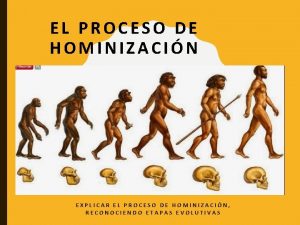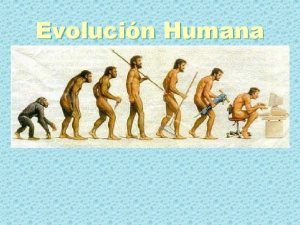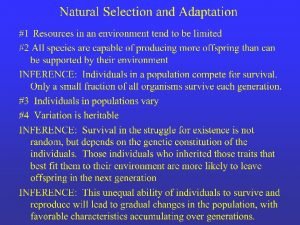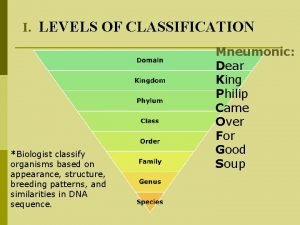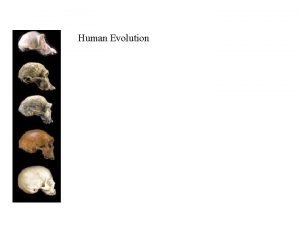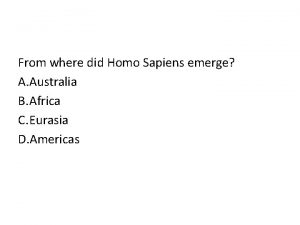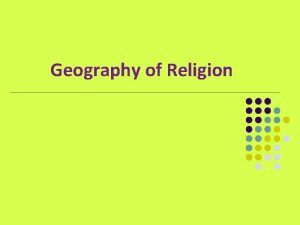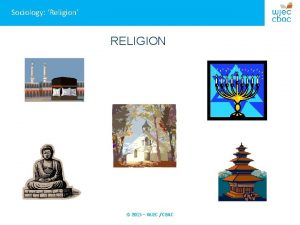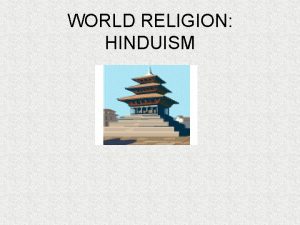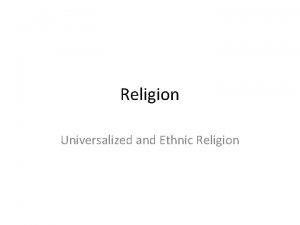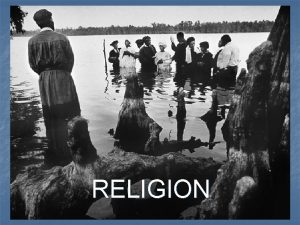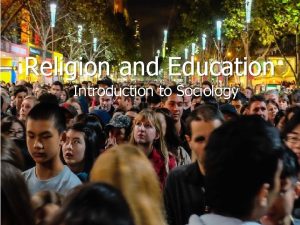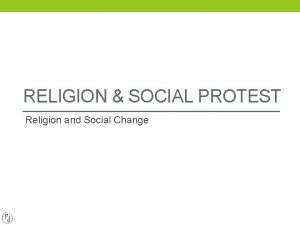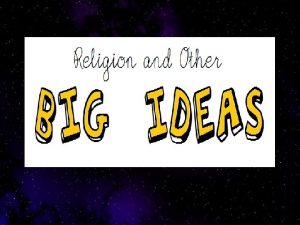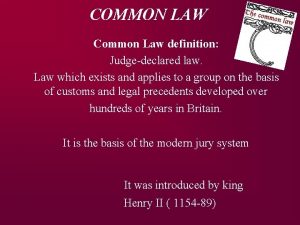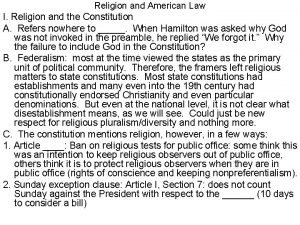Sapiens Chapter 12 The Law of Religion Religion








































- Slides: 40

Sapiens: Chapter 12 “The Law of Religion” Religion Unifies

Examples of Union In the first paragraph of his introduction of the 12 th chapter of Sapiens, Harari begins by painting a detailed picture of unification in an everyday setting that could have been observed in Samarkand. In the second, he offers an example of a religious ritual involving the Ka’aba (a religious shrine) in Mecca as a representation of unification. The common factor between these two places? They areas of major religious concentration and it is no coincidence that there is such unification focused in these areas.

Religion as a Source of Disunion Despite being the third great unifier of mankind, today, religion is often credited with segregating masses of people. Wars and genocides are often associated with religion and the discriminatory actions that those abiding by religious beliefs exhibit are abundant. Many people have turned away from religion as a whole and adopted a more secular and atheistic view of the world.

On the Contrary… Humankind as a whole, relies on many different social orders and hierarchies to enforce organization and cooperation throughout a society. However, these socially constructed structures are, as the author mentioned, imagined and fragile at their cores. In fact, the larger the structure the more fragile it is. The role of religion in maintaining the existence of these fragile and imagined structures and ideas is to provide a sense of legitimacy and credibility through superhuman means.

How? One might ask, “How does religion assert legitimacy in these imagined organizations or ideals? ” This is accomplished by providing the explanation that our laws, organizations, rankings, etc. are not the result of some attempt to impose order on the world by human beings alone. Rather they have been decreed in some sense by a supreme authority outside of and therefore, not subject to the consequences of the rules themselves.

What is Religion Exactly? - In this chapter, Harari defines it as: “A system of human norms and values that is founded on a belief in a superhuman order” - Two specific criteria: 1. Superhuman order Cannot be the product of whims or agreements of humans 2. Binding norms and values Beliefs are the source of moral and behavioral standards

Expansion There are two further qualities necessary to unite a larger expanse of territory: 1. Universal superhuman order The order must be true at any time and in any place 2. The insistence of spreading this belief There must be a goal of spreading the beliefs to everyone Overall, a religion must be universal and missionary in order to flourish and expand to a larger area and obtain a larger, more diverse following.

Examples Islam and Buddhism are referred to as two of the best known religions and are classified as both universal and missionary. Despite the common belief that all religions shared this necessity to spread and become driving forces, most ancient religions were local and exclusive. The followers of these smaller religions had no interest in expanding and imposing their beliefs on others. In fact, the deities and spirits were used to explain problems specific to the tribe that were often exclusively recognized by its members.

Trees and Foxes Animism: a religious belief that souls or spirits exist in non-human entities such as animals, plants, natural phenomena and geographic features as well as in humans. Human norms and values were subject to influence from animals, plants, fairies, ghosts and other supernatural entities used to explain rules and happenings in their communities This was very localized and specific to the area in which the group lived and there was no point in convincing the inhabitants of distant lands to abide by these rules or beliefs.

The Aggy Revolution Plants and animals became property which contrasts the beliefs of the Hunter-gatherers who believed every being was equal and no one creature or being was inferior to any others.

Overly Ambitious Humans This change in status placed certain desires in the minds of humans which could not be completely fulfilled through selective breeding and other worldly techniques Instead, a leading theory about the origin of gods, claims that gods were created because they offered a solution to this problem. Similar to terror management theory?

Anxious Humans The abundant gods and goddesses were narrowed down and the more important gods took center stage and gained a new task: to mediate between the humans and the plants/animals. Supernatural beliefs became less of a means of explaining rules and describing occurrences in nature and more about gaining control through bartering with the beings who controlled the universe. Sacrifices were often made to the gods to symbolize the humans’ devotion to them in exchange for the promise of abundant harvests or fecund flocks. Thus, providing us with a sense of control.

Expansion and Trade As long as people lived in smaller territories, there was no need for anything other than local spirits and deities. The “tree goddess” near the south river provided them with all the protection they needed and the wise white fox would be there to show them where resources were. However, as territories grew and bands became kingdoms, there was a need for an entity of entities whose word ruled over larger areas. Enter: Polytheism

Big Gods and Little Spirits Animism did not disappear at this time. The war god, fertility goddess, and rain god were understood to be the ruling authorities over the world. However, Harari mentions that while the king of the land spent his time making sacrifices to the war god in exchange for a triumph over a rival kingdom, a peasant focused his attention on the fig-tree fairy in hopes that she would cure his sick son.

Man and God The increasing power of polytheism not only changed the status of the gods encompassed in the religion. It also changed the status of humans in nature. Before, Animists believed we were simply another creature in the world surviving and experiencing life. At this point, every occurrence in nature was the result of the relationship between gods and humans. Droughts were the result of a lack if sacrifices, floods were caused by a lack of prayer

A God Among Gods Westerners (monotheists) see polytheism as ignorant and childish. This is probably due mainly to the misconception that polytheism declares there are multiple gods and no one true god ruling over us. On the contrary, polytheism does not dispute the claim that there is one ruling authority. Many, if not all, polytheistic religions include a supreme power that governs even the mighty gods.

Why Don’t They Pray to the Supreme? HE DOESN’T CARE Often, the supreme being in polytheism is devoid of interest or concern for worldly problems. Principal and Teacher example.

Enlightenment The only reason to contact the supreme god would be to seek enlightenment and embrace all of the world: good and bad. There is a desire by these individuals to see the world in the most objective way just as the supreme being would.

Tolerance Polytheism, as a result of the multitude of gods, is very tolerant. There is no need to dispute with or persecute others because the existence of multiple gods was accepted. Even when polytheists conquered an empire, they did not require their new subjects to exclusively recognize their gods. Any shrines or temples built were built alongside the local structures not in their place.

The Exception The Romans only refused to tolerate one god: the monotheistic and evangelizing god of Christianity. It wasn’t that the Romans required the Christians to denounce their belief in the Christian god. They simply expected them to pay respect to the gods of their empire. Once the Christians refused to do so, and rejected any attempts at compromise, the Romans began to view their beliefs as a politically subversive faction and reacted accordingly.

A Half-Hearted Persecution Although the Romans persecuted Christians, in the 300 years between the crucifixion and the rise of the emperor Constantine, Romans initiated only 4 general persecutions of Christians resulting in the death of a few thousand. However, in the next 1, 500 years, Christians killed each other by the millions to settle disputes over slightly different views of the religion noted as focusing on love and compassion.

Christians and Protestants The religious wars between Protestants and Catholics are probably the most well known religious persecutions These two groups both accepted Christ’s divinity and his gospel, but disagreed about the nature of his love. The disputes turned so violent that during the 16 th and 17 th centuries, the two groups killed each other by the hundreds of thousands.

St. Bartholomew’s Day Massacre August 23, 1572: French Catholics attacked communities of French Protestants, resulting in the slaughter of 5, 000 to 10, 000 protestants in the matter of a day. When the pope got word of the event, he was so happy, he organized festive prayers and allegedly dedicated a room in the Vatican to have a mural painted on it of the massacre. Harari states that more Christians were killed in that one day by their fellow Christians than by the Roman Empire throughout its entire existence.

God Is One Some polytheists became so fond of their particular patron god that they began to believe he/she was the one and only god and the supreme universal power. They also maintained the belief that whichever god they began to favor possessed interests and biases that they could manipulate through bargaining and deals. Thus monotheistic religions were born.

Akhenaten and Aten The first monotheistic religion appeared in Egypt, c. 350 BC. A Pharaoh named Akhenaten declared that Aten, a minor deity, was actually the supreme power of the universe. He tried to make the worship of Aten the state religion and eliminate the worship of any other gods. However, after his death, the worship of Aten was abandoned and the people worshipped as they once did.

Marginal Religions Polytheism continued to produce other monotheistic religions but they did not become driving forces in the world because they had little to offer the rest of the world. Judaism for example claimed that the supreme power of the universe not only has interests and bias but that is particularly concerned with the Jewish nation and the land of Israel. Harari describes this as an example of local monotheism.

Christianity began as a small Jewish sect that was intent on convincing the Jews that jesu was the messiah. One of the very first leaders, Paul of Tarsus, thoguht that if the supreme power had incarnated himself in the flesh and died for all of humankind, then everyone should know (not only Jews). Therefore, the spread of this news began to reqch around the world. Eventually, as the word grew, Christianity even took over the great Roman Empire.

Islam The success of Christianity served as a model for Islam, another monotheistic religion that appeared in the 7 th century. Similar to Christianity, Islam began as a small sect in the Arabian peninsula but managed to conquer an empire stretching from the Atlantic ocean to India. The swift and historical changes involving monotheistic religions played a central role in world histroy.

Fanaticism and Missionary Beliefs Monotheists as a whole have been far more fanatical and missionary in their beliefs. If these religions were to accept and recognize the legitimacy of any other faiths it would imply one of two things: Their god is not the supreme power Their god has only provide them with part of the universal message Since monotheists tend not to believe either of these things, they feel compelled to discredit any other religion to validate their own.

Success! This compelling need to discredit other religions drastically changed the game. At the beginning of the first century AD, there weren’t many if any monotheists in the world. Around 500 AD, one of the largest empires – the Roman Empire – was under Christian influence and missionaries were spreading the word of Christianity to parts of Europe, Asia and Africa. From the end of that millennium to today, monotheism has dominated much of the world. Harari notes that the global political order is built around monotheistic foundations.

Still Hanging on! Just as Animism managed to survive within polytheism, polytheism found ways to survive within monotheism. Most likely because people have found it difficult to digest the idea of monotheism in its purest form. Because of this difficulty in accepting monotheism completely, religions began to develop beliefs that resembled polytheistic ideals. Saints in the Christian religion were basically representative of polytheistic gods of older religions. The Brigid/Brigit fiasco.

Dualism Polytheism did give birth to monotheistic religions, but also allowed for the development of dualistic ones. Dualism: believes evil is an independent power, neither created by the good, nor subordinate to it. The entire universe is simply a battleground for these forces and that the results of this struggle are the happenings in the world around us. It is very simple and to-the-point: there is a good force and a bad force and they are constantly battling and we are in the middle. Monotheists have spent a great deal of time attempting to explain how a benevolent and all powerful god could allow his people to suffer, or behave in evil ways.

Drawbacks of Dualism Although it solved the problem of where Evil originated from, another problem of Order arose. Where did the order come from? Surely not from two conflicting beings battling for control. Thus, Harari claims that there must be one omnipotent god who also happens to be evil.

Soroastrianism A prophet named Zoroaster in Central Asia created a religion that passed from generation to generation and became one of the most important dualistic religions. His followers saw the world as a cosmic battle Humans were needed to assist the good god Ahura Mazda. Inspired Gnosticism and Manichaenism.

Manichean Spread from China to North Africa and appeared to be close to defeating Christianity in achieving dominance in the Roman Empire. However, Christianity ruled and dualists were sibsided. Today only a handful of dualists communities survive in India and the Middle East.

Leftovers Monotheistic religions exhibit dualistic beleifs. The Devil and Satan It is contradictory because believing in a good and evil force undermines the power of the omnipotent good being thought to rule the universe. Heaven and hell and body and soul are also examples of dualist beliefs Because of the remanence of other religious beliefs in the monotheistic ones, these religions should e classified as Syncretism.

Natural Law Religions Newer religions such as Jainism, Buddhism, Daoism and Confucianism, Stoicism Cynicism and Epicureanism all disregarded Gods. The superhuman order is product of natural laws Any gods were also subject to the laws of nature

Buddhism Central figure is not a god, but a man, Siddhartha Gautama. Life is a pointless rat race. Suffering is what ails mankind and it is the result of the behavior patterns of one’s own mind. Craving is the driving factor behind all things. When in pain, we crave to escape it. When experiencing pleasure, we crave to maintain it. Training oneself to experience the world and not to crave anything eliminates suffering.

Humanism Liberal Humanism: sanctifies humans and the sacred nature resides within each individual; freedom for individuals Socialist Humanism: humanity is collective rather than individualistic; equality for all Evolutionary Humanism: degenerate into subhumans or evolve into superhumans

How Do We Move Forward? With advances in biological manipulation, are we likely to allow history to repeat itself? How long can we continue to practice liberalism when we are gaining more ways to detect differences,
 Proceso de hominizacion
Proceso de hominizacion Newton's first law and second law and third law
Newton's first law and second law and third law Newton's first law and second law and third law
Newton's first law and second law and third law Boyle's law charles law avogadro's law
Boyle's law charles law avogadro's law Charles law constant
Charles law constant Verifica di storia sugli ominidi terza elementare
Verifica di storia sugli ominidi terza elementare Carte homo sapiens
Carte homo sapiens Virgo weebly geschiedenis
Virgo weebly geschiedenis Memoria concreet 5 oplossingen
Memoria concreet 5 oplossingen Cuadro comparativo entre neandertal y sapiens
Cuadro comparativo entre neandertal y sapiens Ecotest personal dosimeter
Ecotest personal dosimeter Homo sapiens
Homo sapiens Homo sapiens arcaico
Homo sapiens arcaico Arbol filogenético humano
Arbol filogenético humano He was treated like a ____ and cast out from his community.
He was treated like a ____ and cast out from his community. Liepi
Liepi Homo sapiens spelling
Homo sapiens spelling Homo sapiens taksonomi
Homo sapiens taksonomi Phono sapiens meaning
Phono sapiens meaning Play
Play Sebutkan tiga ras pokok homo sapiens ! *
Sebutkan tiga ras pokok homo sapiens ! * Handyman homo
Handyman homo Homo sapiens
Homo sapiens Whats homo sapiens
Whats homo sapiens Características de homoerectus
Características de homoerectus Caracteristicas fisicas de homo sapiens
Caracteristicas fisicas de homo sapiens Sapiens nihil affirmat quod non probet
Sapiens nihil affirmat quod non probet O que é homo sapiens
O que é homo sapiens O que é homo sapiens
O que é homo sapiens Homo sapiens kingdom
Homo sapiens kingdom Levels of taxonomy
Levels of taxonomy Homo sapiens idaltu
Homo sapiens idaltu Homo sinensis
Homo sinensis Torah is the sacred book of
Torah is the sacred book of Sapiens event management
Sapiens event management Homo sapiens neanderthalensis
Homo sapiens neanderthalensis Secneer
Secneer Hát kết hợp bộ gõ cơ thể
Hát kết hợp bộ gõ cơ thể Lp html
Lp html Bổ thể
Bổ thể Tỉ lệ cơ thể trẻ em
Tỉ lệ cơ thể trẻ em
